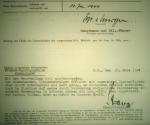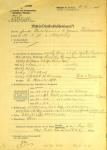-
Posts
4,908 -
Joined
-
Last visited
-
Days Won
97
Content Type
Profiles
Forums
Blogs
Gallery
Events
Store
Everything posted by Dave Danner
-
Gutsche, Bernhard Wilhelm Hermann, born 30.9.1892 in Elversburg, Saarbrücken. Entered service on 15.11.10 as a Fahnenjunker in IR 72. 19.6.12 Leutnant mit Pat. v. 17.6.10, 18.12.15 Oberleutnant. He spent most of the war in IR 72, with various commandments, including to IR 153. Wounded on 16.6.15 by Souchez while commanding 7./IR 72. Wounded again on 14.2.16 by Loos. He was taken prisoner by the British by Le Cateau on 23.10.18 while stellv.Fhr. III./IR 72. Back from captivity on 31.12.19, he remained in the army, going to Kraftfahr-Abt. 1 and Div.San.Abt. Hauptmann on 1.4.22. 1.10.26 transferred to San.Abt. 6, and then discharged on 31.1.29 with Charakter as Major. He remained as a civilian employee of the army until 1933, then came back on active duty as an L-Offizier with the rank of Maj.a.D. and an RDA of 1.10.33. Like most L-Offiziere, he became an E-Offizier on 5.3.35 (new RDA of 1.8.33). On 1.12.35, he was transferred to the staff of Wehrersatz Inspektion Münster (Westfalen) as 2. Kfz.-Vormusterungs-Offz. Promoted to Oberstleutnant on 1.8.39 and Oberst on 1.2.42, and like most E-Offiziere, was transferred to the active officer corps in 1941 (in his case on 1.8.41). He spent the entire war as a Gruppenleiter for Kraftfahrwesen on the staff of WEI Münster. As I mentioned, after a lot of frontline service in WW1 (as a Kp.Fhr. and Btls.Fhr. and as a Rgts.Adj.), he had a relatively undistinguished WW2 career. Probably due to age and WW1 wounds, he had no frontline service in WW2, at least until April 1945 when Münster in Westfalen was on the frontlines. EK2 - 16.9.14 EK1 - 10.12.14 EH3bX - 25.11.14 BT4_ - 21.10.16 (his file says BT4a, but Reichswehr RLs only have BT4b; the BT4a is pinback, so you'd need a picture to confirm) HOH3X - 4.9.18 VAs - 22.7.18 FEK - 23.10.34 WHDA1 - 2.10.36 He only added a KVK2X to what is on the medal bar, so probably never bothered to mount it.
-
He has a non-commissioned officer's long service cross and the Prussian General Honor Decoration, which was awarded to NCOs and lower level civil servants. Perhaps a retired senior NCO recalled for service on the home front with the Stellvetretender Generalkommando IXI.Armeekorps in Altona, since the corps area covered Mecklenburg-Schwerin and Hamburg. These two had the largest contingents in the Prussian Army in that corps after Prussia itself.
-

Soviet help with Iding awards
Dave Danner replied to Paul C's topic in USSR: Soviet Orders, Medals & Decorations
2, 4, 6 and 7 are jubilee/anniversary medals from the period between 1965 and 1975: 2 - Lenin Centenary Medal (Jubilee Medal "In Commemoration of the 100th Anniversary since the Birth of Vladimir Il'ich Lenin") 4 - Jubilee Medal "50 Years of the Armed Forces of the USSR" 6 - Jubilee Medal "Thirty Years of Victory in the Great Patriotic War 1941–1945" 7 - Jubilee Medal "Twenty Years of Victory in the Great Patriotic War 1941–1945" -

Soviet Identifing Orders and translation
Dave Danner replied to Paul C's topic in USSR: Soviet Orders, Medals & Decorations
Hi Paul, The badge appears to be a proficiency badge. "Excellent Artilleryman" or the like. I don't think there's enough detail to tell which. See this thread: http://gmic.co.uk/index.php/topic/1720-otlichnik-excellence-badges/ The top says "In memory of the Great Patriotic War 1941-45". The bottom says "Our cause is just" and "We are victorious".- this is the same as the text on the obverse of the Medal for Victory Over Germany. -

Heer Ribbon bars - ID possible?
Dave Danner replied to drspeck's topic in Wehrmacht Medals, Decorations & Awards
OK, since I understand you have the bar now... Generalleutnant Werner Pinckvoß: http://www.lexikon-der-wehrmacht.de/Personenregister/P/PinckvossWerner.htm Here is his entry from the 1929 rank list showing his awards. PS: All I see is a tiny thumbnail. I have no idea why even small images are shrunk even smaller. -
His China Medal was in steel. On the ennoblement, you are correct. He was awarded the Merit Order of the Bavarian Crown on 5.1.17 and entered into the Adelsmatrikel on 15.2.17 for that reason. Edit to add: as for the reason for awarding the Bavarian Crown, someone can correct me if I am wrong, but I think it was customary in Bavaria to grant a life patent to those who had achieved the rank of divisional commander. The only Generalleutnants before the war who were not ennobled were garrison and Landwehr-Inspektion commanders, and the only divisional commanders to not be ennobled did not command divisions until late in the war, so they missed their chance.
-
A Royal Saxon officer. With only a handful of exceptions, the Verdienstorden* was only awarded to Saxons. More than 500 Saxon officers received the Sachsen-Meiningen Ehrenkreuz für Verdienste im Kriege, and they were in a lot of different units, although a lot went to GR 100 and IR 133 and their corresponding reserve and Landwehr regiments. * Lots of sources call it the Zivil-Verdienstorden, but the "Zivil" part was dropped on 24 September 1849.
-
The only infantry unit with contingents from both Anhalt and Braunschweig was Landwehr-Infanterie-Regiment Nr. 93. It was formed on 2.8.15 by IV.Armeekorps with two Landsturm battalions, one from Bernburg and one from Altenburg. Landw.Brig.Ers.Btl. Nr. 38, a Hannoverian/Braunschweig battalion, joined LIR 93 on 7.7.16 as III/LIR 93. But an Anhaltiner serving in a Braunschweig regiment, or vice versa, might be more likely. Or an Anhaltiner in the Zieten'sche Husaren, since Duke Ernst August awarded the BrK2 to his old regiment as if it were a native Braunschweig regiment. Dave
-
Hi Iron Cross 2nd Class Saxon Military Order of St. Henry, Knight's Cross Saxon Merit Order, Knight 2nd Class with Swords Saxon Albert Order, Knight 1st Class with Swords Saxon Albert Order, Knight 2nd Class with Swords Hamburg Hanseatic Cross ? - looks like a Württemberg Friedrich Order Honor Cross for Combatants Austrian Military Merit Cross 3rd Class with War Decoration Bulgarian - either the Bravery Order or the Military Merit Order on the ribbon of the Bravery Order Turkish War Medal Dave
-
It says "Sommer 1918 als Kdr. Inf. Rgt. Graf Barfuß". Stobbe would make sense, unless it's Eduard v. Kaweczynski, and the photo was taken before Stobbe took over, while the letter itself was dated after. Despite commanding an infantry regiment, Stobbe was a Pionier officer - does that match the uniform? Stobbe didn't get his Pour le mérite until November 1918, so its absence fits.
-
Hermann Korhammer, born 17 April 1890 in Augsburg, Bayern. 25.5.17 Lt.d.R. d. 3.bay.IR, 18.3.21 char. OLt.d.R.a.D. From 30.5.17 to 19.10.18, he was with the 1.MGK of Ldst.-Inf.-Btl. Landshut I.B/7, when he became Stellv. Kp.Fhr. of the 2.MGK of the same battalion. So I would guess the box dates from right around when he was commissioned. Google says a Hermann Korhammer (1890-1973) was co-author in 1965 of "Gemeindewappen des Landkreises Augsburg". Augsburg and 1890, so probably him.
-
Yes, it is the Order of St. Alexander Nevsky. The last three medals on the medal bar, after the French Legion d'Honneur, are the Ottoman gold and silver Imtiaz Medals and the gold Liakat Medal. Below these, behind the Hohenzollern breast star, is the Ottoman Order of Nishan-e Iftihar with Brilliants. The sash is for the Order of the Black Eagle. Here is his entry from the 1914 rank list:









